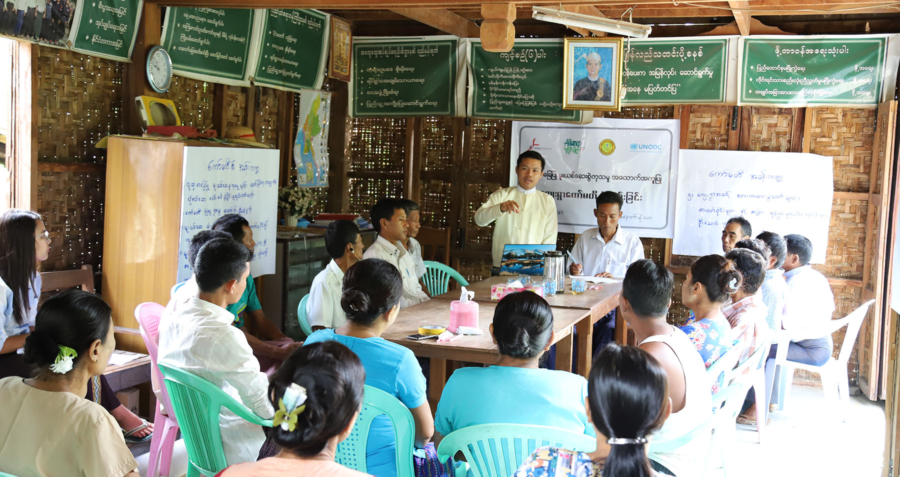The seven Myanmar villages supporting people who use drugs
 © Mahamate
© Mahamate
Insights from the first community-based harm reduction, treatment and care pilot to be recognised by the country’s Ministry of Health.
In recent years Myanmar has taken important steps towards harm reduction, away from a punitive approach to drug use. A more supportive environment for people who use drugs has begun to seem possible.
Since 2017, Alliance Myanmar Mahamate, through the Programme to Inspire, Transform and Connect the HIV Response (PITCH), has been leading the campaign to change the country’s drug policies. In 2018, when the government released a new drug policy that included harm reduction we had cause to celebrate. This shift was significant, but translating policy into action remains challenging – and this is where seven villages in Kalay, an area with high levels of injecting drug use, come in.
In September last year, Mahamate, PITCH and UNODC began working with these villages to pilot the first community-based harm reduction, treatment and care project for people who use drugs recognised by the Ministry of Health. By showing that residents can help people who use drugs, to not only access care and treatment but become socially integrated, we plan to make the case nationally that support for people who use drugs is far more effective than punishment.
CREATING CHANGE for people who use drugs
The pilot has four layers to ensure on-the-ground realities reach those in positions of power. There are (or will be) groups led by people who use drugs, seven committees (one for each village), an additional joint village committee focusing on provincial advocacy work, and a national steering committee consisting of civil society organisations and government officials, including those from health, social welfare, education, the police and the judiciary.
A pre-pilot assessment indicated that many village heads thought punishing people who use drugs was the best approach to take. So we debated with them UNODC’s 12 principles of community-based treatment and harm reduction. Slowly we sensitised them about the effectiveness of respecting the human rights of people who use drugs. Through their help we have sensitised other villagers.
After repeated meetings and capacity building, we have seen people change their minds. For instance, in a recent evaluation, U Khin Maung Win, who now chairs the joint committee, told us: “mobilising people who use drugs will be challenging…they may not trust us [but]… I want to prove it and succeed.” A recent evaluation of community members found that 40% better understand UNODC’s 12 principles – this may not be everyone, but it does show that altering attitudes is possible.
Eventually the goal is for people who use drugs to advocate for the services they need. But making people who use drugs visible before other villagers are sensitised could put them at harm. We’ve seen other projects where this has been the case. Focusing on the general population first is so important.
AGREEING AIMS
We held focus groups with villagers before we began to define the project’s goals. One of the key aims is to ensure naloxone, which can reverse opioid overdoses, and methadone are locally available.
We are already seeing some success here. In February, the district health department said it would train village-level health workers to provide naloxone, and informal reports suggest methadone will be provided locally soon. In the meantime, a committee has referred 12 people who use drugs to receive detox treatment in Kalay hospital. They hired a car for 12 days so these people could be driven to the hosptial, and are documenting this to show the difficulty of receiving care at a long distance. They will use this evidence to build the case that methadone should be made available locally.
Villagers are also advocating to stop arbitrary arrests of people who use drugs, and for free vocational training to be made available. Providing training people who use drugs has been trialled before, but it wasn’t based on what would be useful so it wasn’t successful. We want to ensure vocational training meets the needs of people who use drugs and the local market.
Another aim is to socially reintegrate people who use drugs. Committees had started to look at this, for instance, through religious events or football games. Requirements for social distancing that are now in place due to COVID-19 mean some of these ideas will have to change, but we will find a way.
WORKING IN A ‘NEW NORMAL’
It’s not just the pilot’s social integration activities that COVID-19 is affecting; every aspect is impacted in some way. Lockdown lifted in Kalay on 15 May and we are now looking at how to hold village meetings safely. Because the government’s supply of face masks is in short supply, during the Support. Don’t Punish global day of action in June, individual committee members are planning to provide masks and information on harm reduction to government health workers. We want to make the point that, if you cannot stay at home you can reduce the harm of COVID-19 by wearing masks. It is all about finding the opportunities where we can.
When the travel ban is lifted we will resume work on changing the mindsets of those influential villagers who are yet to be convinced to become committee members. If they are sensitised then other villagers will follow. As attitudes change towards people who use drugs, within the villages and beyond, we will use the evidence of what is being achieved in Kalay to show the rest of Myanmar what is possible.
The Partnership to Inspire, Transform and Connect the HIV response (PITCH) is a joint partnership between Frontline AIDS, Aidsfonds and the Dutch Ministry of Foreign Affairs. Yan Win Soe is the country focal point for Myanmar in the PITCH programme.
Tags
Harm reductionPeople who use drugsPITCHSupport. Don't Punish

